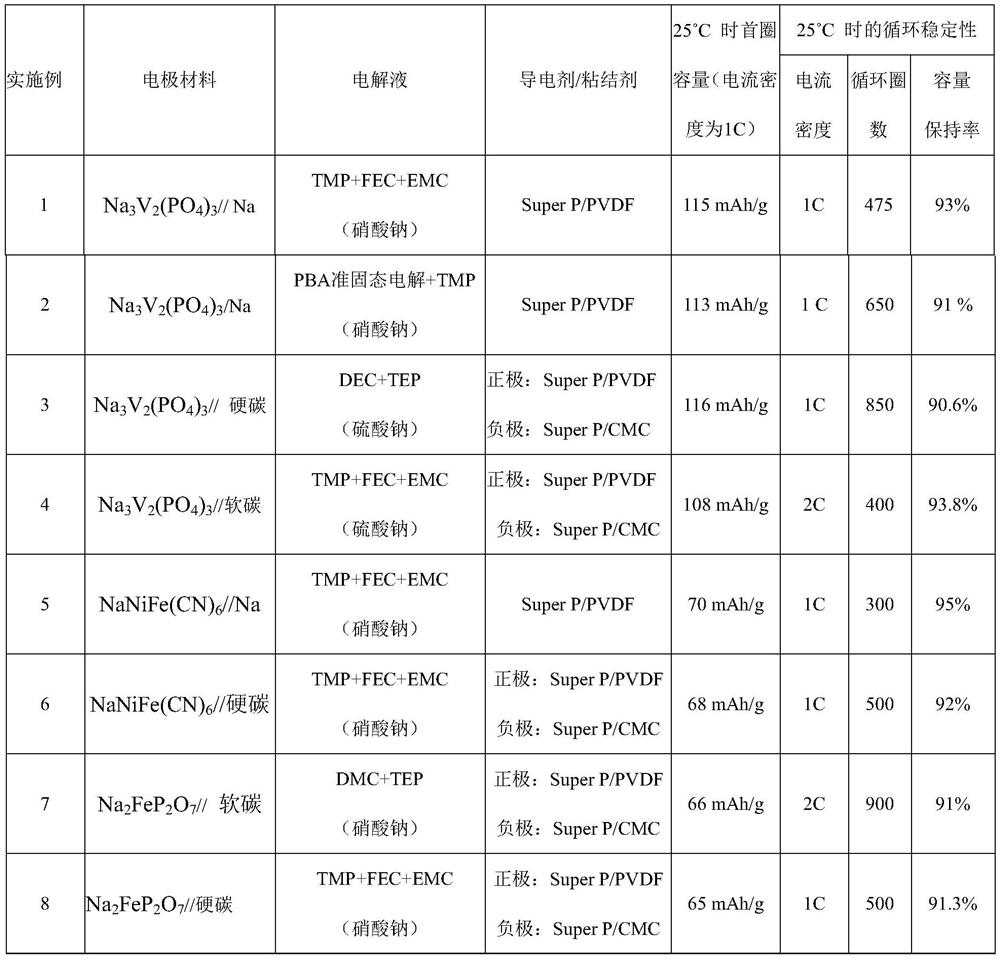Non-combustible high-safety sodium ion battery
A sodium-ion battery, high-safety technology, used in secondary batteries, climate sustainability, non-aqueous electrolyte batteries, etc., can solve problems such as hidden dangers, flammability, hinder practical application, etc. Cost, low cost effect
- Summary
- Abstract
- Description
- Claims
- Application Information
AI Technical Summary
Problems solved by technology
Method used
Image
Examples
Embodiment 1
[0022] Trimethyl phosphate (TMP), fluoroethylene carbonate (FEC), and ethyl methyl carbonate (EMC) were mixed according to a volume ratio of 1:1:2, and then sodium nitrate was added to form a 1mol / L solution. Put the prepared electrolyte on the flame of the alcohol lamp for 10 seconds, and the electrolyte is not ignited. Take Na 3 V 2 (PO 4 ) 3 as a positive electrode active material. The preparation of the positive electrode sheet is as follows: according to the active material (Na 3 V 2 (PO 4 ) 3 ): conductive agent (super P): binder (polyvinylidene fluoride PVDF) = 80:10:10 mixed slurry, coated on the surface of carbon-coated aluminum foil to form a positive electrode sheet. Secondly, metal sodium (Na) was used as the negative electrode material, and Celgard 2500 film was used as the separator to assemble a 2032 button battery. At room temperature of 25°C and a current density of 1C, the first-cycle capacity is 115mAh / g. After 475 cycles, the capacity retention rat...
Embodiment 2
[0024] Mix trimethyl phosphate (TMP), fluoroethylene carbonate (FEC), and ethyl methyl carbonate (EMC) in a volume ratio of 1:1:2, and then add 30% volume ratio of acrylic acid to the homogeneous solution Butyl ester monomer, then add sodium nitrate to make a 1mol / L solution. Azobisisobutyronitrile (AIBN) was then dissolved in the solution as a thermal initiator. The resulting solution was injected into glass molds with silicone spacers. Finally, the electrolyte was heated at 70 °C for 12 h to obtain a quasi-solid state highly concentrated electrolyte. Put the prepared quasi-solid electrolyte on the flame of the alcohol lamp for 10 seconds, and the electrolyte is not ignited. Take Na 3 V 2 (PO 4 ) 3 as a positive electrode active material. The preparation of the positive electrode sheet is as follows: according to the active material (Na 3 V 2 (PO 4 ) 3 ): conductive agent (super P): binder (polyvinylidene fluoride PVDF) = 80:10:10 mixed slurry, coated on the surfac...
Embodiment 3
[0026]Mix diethyl carbonate (DEC) and triethyl phosphate (TEP) at a volume ratio of 3:1, and then add sodium sulfate as a solute to prepare an electrolyte solution with a concentration of 1 mol / L. Put the prepared electrolyte on the flame of the alcohol lamp for 10 seconds, and the electrolyte is not ignited. Take Na 3 V 2 (PO 4 ) 3 as a positive electrode active material. The preparation of the positive electrode sheet is as follows: according to the active material (Na 3 V 2 (PO 4 ) 3 ): conductive agent (super P): binder (polyvinylidene fluoride PVDF) = 80:10:10 mixed slurry, coated on the surface of carbon-coated aluminum foil to form a positive electrode sheet. Secondly, hard carbon is used as the negative electrode active material. Hard carbon: conductive agent (super P): binder (sodium carboxymethyl cellulose CMC) = 80:10:10 mixed slurry, coated on the surface of copper foil to form a negative electrode sheet. A 2032 coin cell was assembled using Celgard 2500 ...
PUM
| Property | Measurement | Unit |
|---|---|---|
| current efficiency | aaaaa | aaaaa |
| current efficiency | aaaaa | aaaaa |
| current efficiency | aaaaa | aaaaa |
Abstract
Description
Claims
Application Information
 Login to View More
Login to View More - R&D
- Intellectual Property
- Life Sciences
- Materials
- Tech Scout
- Unparalleled Data Quality
- Higher Quality Content
- 60% Fewer Hallucinations
Browse by: Latest US Patents, China's latest patents, Technical Efficacy Thesaurus, Application Domain, Technology Topic, Popular Technical Reports.
© 2025 PatSnap. All rights reserved.Legal|Privacy policy|Modern Slavery Act Transparency Statement|Sitemap|About US| Contact US: help@patsnap.com


